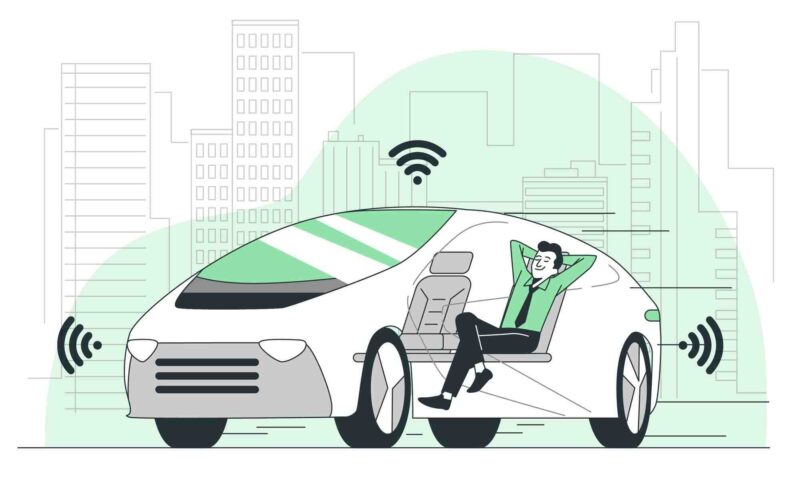Prospects of Self-driving Cars
Introduction
What is a self-driving car?
How do self-driving cars work?
What are the advantages and disadvantages of self-driving cars?
What is a self-driving car?
A vehicle that utilizes a combination of sensors, cameras, radar, and artificial intelligence to move between locations without a human driver is referred to as a self-driving car, which is also called an autonomous or driverless car. A vehicle must be capable of navigating to a predefined location across roads that have not been modified for its usage in order to be considered completely autonomous. Although the technology exists, there are currently no completely self-driving vehicles. Tesla cars can, in certain circumstances, drive themselves, but still, motorists must concentrate on the road (Meyer, 2022).
How do self-driving cars work?
1. Building a map
Unmanned cars need to map the surrounding environment and place the discovered objects on the map to understand the relative environment. Typically, lidar and camera technologies are used to scan the surroundings, and automotive computers integrate sensor, GPS, and IMU inputs to create maps.
2. Route planning
Route planning is the process of finding the safest and fastest route to a destination. Unmanned cars need to consider navigation and be able to operate around road objects, such as fixed and moving obstacles, lanes, and other moving vehicles. Path planning begins with a long-distance plan similar to the direction currently received when you enter an address in the map application. A short-term plan is then created and continuously refined as the vehicle moves.
3. Obstacle avoidance
Mapping and route planning involve avoiding stationary and moving obstacles, such as pedestrians. Self-driving vehicles constantly draw maps of their perimeter. They involve all visible and forecasted obstacles and use machine learning to decide the identity of particular objects. From here, the computer can see their forecasted behavior. For example, a computer in a self-driving car can distinguish a motorcycle from a bicycle, and thus, determine how to avoid it. Since obstacles may not be visible and, therefore, cannot be detected by sensors in cars, it would be ideal for autonomous vehicles to communicate with each other continuously over a wireless connection. If one car encountered an obstacle, it could immediately warn the other cars so that they could adjust their routes (Meyer, 2022).
What are the advantages and disadvantages of self-driving cars?
Advantages of autonomous vehicles
• 360° sight. Although humans have a viewing angle of only 180°, autonomous vehicles have the ability to view the environment in the 360° range, which is twice as much as humans, using high-precision technology.
• Reduced accidents. Accidents will be greatly reduced because autonomous cars have a 360-degree vision and self-driving vehicles are interconnected, which allows for the possibility of continuous communication. In the beginning, accidents will not be completely eliminated, but they will be much less likely than when people drive.
• Access for people with disabilities and mobility difficulties. Since cars will be autonomous and humans will not drive themselves, people with visual or hearing impairments will also be able to use autonomous vehicles. In other words, it will be inclusive.
Disadvantages of autonomous vehicles
• Data protection issues. The first downside of autonomous cars is that they can be a cyber issue of data protection because they are always connected to the entire environment. Accurate handling of the road network can also be damaged.
• Implementation costs are high. Since the self-driving car infrastructure still revolves around expensive 5G network coverage, it may take a long time for the government to invest in enough infrastructure to help self-driving cars maximize performance.
• Vehicle prices are high. Although the cost of making parts for self-driving cars has been significantly reduced, it is still a burden for the average family to use self-driving cars. It will take more years before they become universal and are within the reach of the middle class (Tenorio, 2021).
Conclusion
Although advances toward fully autonomous vehicles continue, technology and adaptations to make this type of vehicle still need to develop further. More self-driving cars are expected to run on highways over the next decade. However, more congested areas with non-standard road signs and areas with more pedestrians will not be suitable for self-driving cars until decades later.
Reference
Meyer, S. (2022). How Do Self-Driving Cars Work? | The Zebra. [online] www.thezebra.com. Available at: https://www.thezebra.com/resources/driving/how-do-self-driving-cars-work/ [Accessed September. 2022].
Tenorio, E.M. (2021). Advantages and disadvantages of autonomous vehicles. [online] BBVA.CH. Available at: https://www.bbva.ch/en/news/advantages-and-disadvantages-of-autonomous-vehicles/ [Accessed September. 2022].
